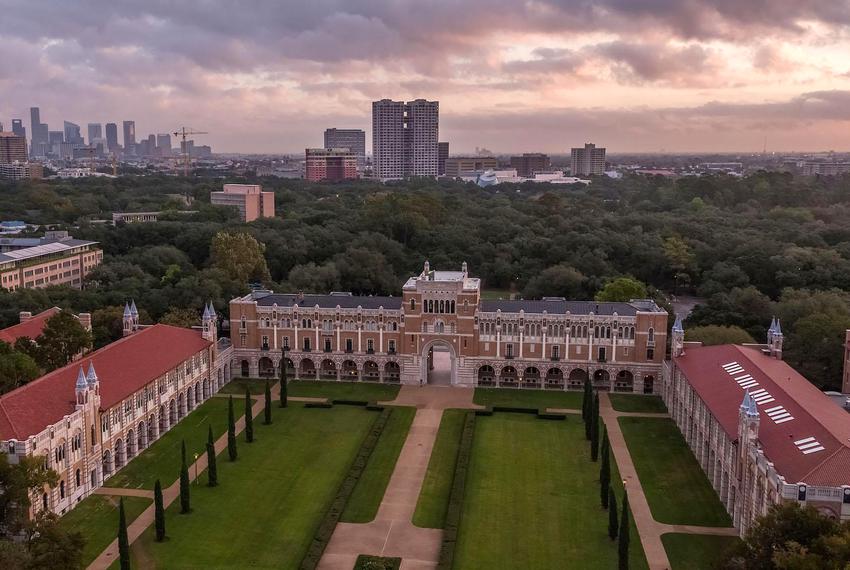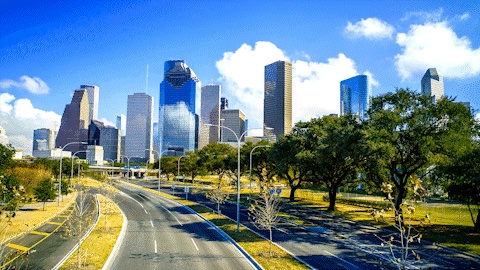Houston is the most diverse city in the United States and the largest city in the state with more Blackfolk than any other. Yet, even as Houston has tried historically to put on a good face as an example of a new or different south from the 1900s to the 1960s, racism never took a break (see 1917 Camp Logan Rebellion, 1967 Houston Police Department attack upon Texas Southern University and TSU students erroneously labeled a student riot, the 1960s attempts to avoid major protests during the Civil Rights Movement, the 1989 HPD killings of Ida B. Delaney and Byron Gillum, etc.), white supremacy remained and remains a constant presence.
Editor’s note: This article originally ran June 18, 2021.
“We walk on streets and attend schools named after slave traders and fanatical racists and people who built their fortunes on the backs of unnamed and forgotten Black people,” stated Kimathi Nelson, presiding bishop of the Shrine. “We are surrounded by symbols, monuments, institutions and places that serve as reminders of our painful past and reinforcers of our supposedly inferior status. White supremacy is embedded in everything.”

“Attacks on Critical Race Theory and history from perspectives other than those of wealthy, white men, and policies like Texas Governor Greg Abbott’s 1836 Project which supposedly promotes ‘patriotic education,’ merely protect racist reads of history,” according to African American History instructor Edward Vincent. “This racist history is also protected daily by our ignorance.”
To fight that ignorance, the Defender compiled some local examples of racist landmarks and institutions we see daily in and around the Bayou City.
Streets

Dowling & Tuam: When Black people of Houston came together and pooled their money to buy land after the Civil War, they named the acreage “Emancipation Park.” The Houston City Council, offended by the very notion of formerly enslaves Blacks owning land, voted to name the streets bordering the acreage Dowling and Tuam. Dowling was named after Richard William Dowling, a Confederate hero. Tuam was the name of the town in Ireland where Dowling was born.

Fannin St. is named after James Walker Fannin Jr., a slave-owner who instigated war with Mexico to steal Mexico’s land to expand slavery westward, that land was Texas.
Milam St. is named after Benjamin Milam who was another slave-owner participating in the same conspiracy to steal Texas and expand slavery.
Kirby St. is named after John Henry Kirby who built an oil and timber empire by exploiting Black laborers. He then used his massive fortune to support pro-segregation organizations including the Ku Klux Klan.


Holcombe Blvd. is named after Oskar Fitzallen Holcombe who was Houston’s staunch segregationist mayor for 22 years. His long tenure was due to a reputation for knowing how to keep n*ggers in line.

Westheimer Rd. is named for Mitchell Louis Westheimer, owner of the Westheimer Plantation who built up his landholdings by driving Black people off their small family farms then forcing them into employment as sharecroppers on land they used to own.
Schools
Rice University is named after William Marsh Rice. He made his fortune as a slave-trader and slave-owner. He wrote in the university’s charter that the school was established exclusively for the education of the white inhabitants of Houston.


Lamar High School, Lamar Consolidated High School and Lamar University are named after Mirabeau Buonaparte Lamar, a slave trader and a genocidal maniac who became the second president of the Republic of Texas and advocated the total extinction of Indians in Texas.
Other institutions
Harris County is named after John Richardson Harris, a New Yorker who was given a land grant of 4,400 acres in 1790 around the junction of Brays and Buffalo Bayous. He used slave labor to do the back-breaking work of clearing the land, draining the swamps, and transforming the wilderness into a town.

MD Anderson Cancer Center and MD Anderson Library (University of Houston) are named after Monroe Dunaway Anderson who made his immense fortune by exploiting Black sharecroppers who picked his cotton.
What now?
Some contend that to call for name changes of these landmarks is “cancel culture” and “wokeness” gone wild, as the individuals in question were merely operating within the context of the times in which they lived. Edward C. Halperin, chancellor and CEO of New York Medical College in Valhalla, New York is one of those people.
Speaking on the movement to remove such names from buildings and parks, Halperin stated in a June 29, 2020 USA Today editorial, “When one considers the number of American streets, municipalities, states, public buildings, public school buildings, university buildings and universities named in honor of individuals who were either slave owners during the time of slavery in the United States or who expressed racist views, one must wonder ‘Where will we draw the line?’”
Others believe removing such names is our civic duty and moral responsibility.

Anthony Collier, University of Texas law school student and president of the National Black Law Students Association, speaking on efforts to remove his school’s fight song “The Eyes of Texas,” said, “The phrase, ‘The Eyes of Texas are upon you’ comes from confederate leaders who used that term to inspire confederate troops to fight to keep Black people enslaved.”
The logic Collier and others use to fight to “retire” “The Eyes of Texas” is the same logic that led Houstonians to successfully remove confederate hero Dowling’s name from the 3rd Ward street (now Emancipation Avenue) and Houston Independent School District school (now Audrey H. Lawson Middle School) that once bore his name.
However, opinions are split regarding how Houstonians should proceed.
Activist Akachi Azubike advocates changing all names deemed racist.
“Each time we call the names of another people’s ancestors we know were oppressive, exploitive or antagonists to African Americans, weevoke the energy of their legacy and spirit to continue living. We must stop giving them life and replace their names with our ancestors whose legacies and spirit we want to live on, especially in our communities.
Dr. Abdul (Robert) Muhammad agrees with focusing on change, but only in our neighborhoods.

“Where we are the majority owners of land in neighborhoods, the streets should reflect our heroes, heroines and history. To go beyond that, we face the ire and backlash of the descendants of those who believe their forefathers stole this country (and us from Africa) “fair and square. And are sick of ‘political correctness.”
For now, the names Lamar, MD Anderson, Westheimer and others still stand as reminders of Houston’s past.
Offensive names of Texas geographical sites removed after years of struggle
Thirty years ago, Harris County Commissioner Rodney Ellis, then a state senator, co-sponsored legislation calling to change the names of 19 geographical sites in Texas with racially offensive names. This year, however, 16 of the original sites still bore these offensive names. Together, Commissioner Ellis, U.S. Rep. Al Green, State Sen. Borris Miles and State Rep. Ron Reynolds have been advocating for bold federal leadership to change these names. Recently, the U.S. Board on Geographic Names formally approved the name changes for 16 geographical sites in Texas.
“This day has been a long time coming, but I am proud to see this change finally happen. In this moment of racial reckoning, we must follow up our verbal commitments to racial justice with action,” Commissioner Ellis said. “I commend the U.S. Board on Geographic Names for taking bold and swift action, and speeding up this process over the past few months so that the state of Texas no longer has these 16 geographical sites that bear the racist and offensive word ‘negro’ in them.
“However, the work is not done. Since the original legislation, 11 other sites were identified in Texas with the term ‘negro’ in them located on private land. Across our country there are still hundreds of geographic sites with racially offensive names that target Black, Hispanic, and Native communities. I hope that the USBGN will build on the progress made today in Texas, and work with other groups across the country to ensure that all racially offensive names are erased from the public domain.”
Said Congressman Green: “I am proud to know that the U.S. Board on Geographic Names has taken a step in the right direction by formally approving name changes that will remove racist place names of 16 geographical sites in Texas. Now, instead of reminders of our bigoted past with names like ‘Negrohead Lake,’ Texans can traverse the state and learn about notable figures like African-American Judge Henry Doyle when in Baytown visiting the lake now renamed in his honor. As a son of the segregated South, I am opposed to anyone experiencing or reliving the horrors of racism when visiting geographic landmarks. This is why I am an original co-sponsor of former Rep. Deb Haaland’s (now Secretary of Interior) Reconciliation in Place Names Act and why I am eager to reintroduce the legislation this Congress.”
Despite legislation at the state level that should have changed the names of all geographic sites in Texas with racially offensive names back in 1991, over the years only three of these were actually renamed. Earlier proposals to make the changes had been rejected by the board on the grounds that there was not enough local involvement in the renaming process.
State Sen. Miles, who wrote a Senate Concurrent Resolution urging the USBGN to approve all the name changes in Texas, said, “the perpetuation of racially offensive language is a stain on the Lone Star State, and it is vital that the names of these geographic features be changed in order to reflect and honor the diversity of the population.”
State Rep. Reynolds commented: “Protests over racial inequality have now spurred a new reckoning over confederate monuments, schools, symbols and street names to be renamed and statutes felled. They represent institutional racism and white supremacy, and it is past time for changes. I want to thank the U.S. Board On Geographic Names for moving quickly and agreeing to remove and change these racially offensive names.”
The list of geographic sites includes a lake in Baytown, located in Harris County, named “Negrohead Lake,” which will now become “Lake Henry Doyle.” The Harris County Commissioners Court and the Baytown City Council both adopted resolutions supporting the name change in February.
The full list of geographic sites and their new names is below.
| Negrohead Lake | Lake Henry Doyle |
| Negro Branch | Ada Simond Creek |
| Negrohead | Bill Pickett Hill |
| Negro Creek | Buffalo Soldier Creek |
| Negro Hollow | Freedom Hollow |
| Negro Bend | George Ruby Bend |
| Negrohead Bluff | Hendrick Arnold Bluff |
| Negro Head | Henry Flipper Hill |
| Negro Creek | Jack Johnson Creek |
| Negro Hollow | John Horse Hollow |
| Negro Creek | Kiamata Creek |
| Negro Lake | Lake William Goyens |
| Negro Hollow | Leonard Harmon Hollow |
| Negro Tank | Matthew Hooks Reservoir |
| Negro Creek | Milton Holland Creek |
| Negro Gully | Norris Cuney Gully |











